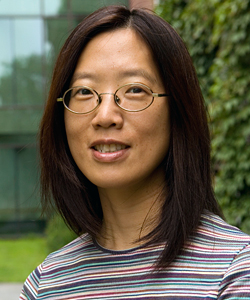Home > Press > Dartmouth researchers discover chromium's hidden magnetic talents
 |
| Yeong-Ah Soh (photo by Joseph Mehling '69) |
Abstract:
Two Dartmouth researchers have determined that the element chromium displays electrical properties of magnets in surprising ways. This finding can be used in the emerging field of "spintronics," which might someday contribute to new and more energy-efficient ways of processing and storing data.
Dartmouth researchers discover chromium's hidden magnetic talents
Hanover, NH | Posted on April 16th, 2008The study, titled "Electrical effects of spin density wave quantization and magnetic domain walls in chromium," will be published in the April 17 issue of the journal Nature.
Electrons have an intrinsic angular momentum, called spin, in addition to their electrical charge. In electronics work, it is the charge of the electron that is used for calculations and transmitting information. In spintronics, it is the electron spin that is exploited.
"The phenomena that we have discovered are likely to lead to new applications of chromium," says Yeong-Ah Soh, the lead researcher on the paper and an associate professor of physics and astronomy at Dartmouth. She worked on the study with Ravi Kummamuru, a former post-doctoral research associate at Dartmouth now at the University of Illinois at Urbana-Champagne.
She goes on to explain that in essence, this indicates that a simple and well-known element, chromium, displays different electrical properties on heating and cooling. These differences reflect subtle internal rearrangements of the electrons and their spins.
In ferromagnets, the kind of common magnet you might see on a refrigerator, the spins of electrons interact with each other leading to alignment. In antiferromagnets, however, the interactions between neighboring electron spins are such that they are opposed. Researchers have long studied the electrical properties of ferromagnets and the influence of electron spin. Less attention has been paid, according to Soh and Kummamuru, to the influence of spin on the electrical properties in antiferromagnets, where it is more difficult to manipulate, and chromium is special since it is the only simple element that is an antiferromagnet.
"Antiferromagnets are used in numerous fields: physics, materials science, and chemistry, and they are increasingly used in technology, where they are found in the tiny heads that read the data on computer disc drives," says Soh. "Our research opens the entire new field of controlled electrical effects at a slightly-larger-than-quantum scale in antiferromagnets. The findings show that not only ferromagnets can be used in spintronics; there is a possibility that antiferromagnets can also be employed to manipulate and store information."
####
About Dartmouth College
Dartmouth College educates the most promising students and prepares them for a lifetime of learning and of responsible leadership, through a faculty dedicated to teaching and the creation of knowledge.
For more information, please click here
Contacts:
Susan Knapp
(603) 646-3661
Copyright © Dartmouth College
If you have a comment, please Contact us.Issuers of news releases, not 7th Wave, Inc. or Nanotechnology Now, are solely responsible for the accuracy of the content.
| Related News Press |
News and information
![]() Simulating magnetization in a Heisenberg quantum spin chain April 5th, 2024
Simulating magnetization in a Heisenberg quantum spin chain April 5th, 2024
![]() NRL charters Navy’s quantum inertial navigation path to reduce drift April 5th, 2024
NRL charters Navy’s quantum inertial navigation path to reduce drift April 5th, 2024
![]() Discovery points path to flash-like memory for storing qubits: Rice find could hasten development of nonvolatile quantum memory April 5th, 2024
Discovery points path to flash-like memory for storing qubits: Rice find could hasten development of nonvolatile quantum memory April 5th, 2024
Spintronics
![]() Quantum materials: Electron spin measured for the first time June 9th, 2023
Quantum materials: Electron spin measured for the first time June 9th, 2023
![]() Linearly assembled Ag-Cu nanoclusters: Spin transfer and distance-dependent spin coupling November 4th, 2022
Linearly assembled Ag-Cu nanoclusters: Spin transfer and distance-dependent spin coupling November 4th, 2022
Discoveries
![]() Chemical reactions can scramble quantum information as well as black holes April 5th, 2024
Chemical reactions can scramble quantum information as well as black holes April 5th, 2024
![]() New micromaterial releases nanoparticles that selectively destroy cancer cells April 5th, 2024
New micromaterial releases nanoparticles that selectively destroy cancer cells April 5th, 2024
![]() Utilizing palladium for addressing contact issues of buried oxide thin film transistors April 5th, 2024
Utilizing palladium for addressing contact issues of buried oxide thin film transistors April 5th, 2024
Announcements
![]() NRL charters Navy’s quantum inertial navigation path to reduce drift April 5th, 2024
NRL charters Navy’s quantum inertial navigation path to reduce drift April 5th, 2024
![]() Discovery points path to flash-like memory for storing qubits: Rice find could hasten development of nonvolatile quantum memory April 5th, 2024
Discovery points path to flash-like memory for storing qubits: Rice find could hasten development of nonvolatile quantum memory April 5th, 2024
|
|
||
|
|
||
| The latest news from around the world, FREE | ||
|
|
||
|
|
||
| Premium Products | ||
|
|
||
|
Only the news you want to read!
Learn More |
||
|
|
||
|
Full-service, expert consulting
Learn More |
||
|
|
||








